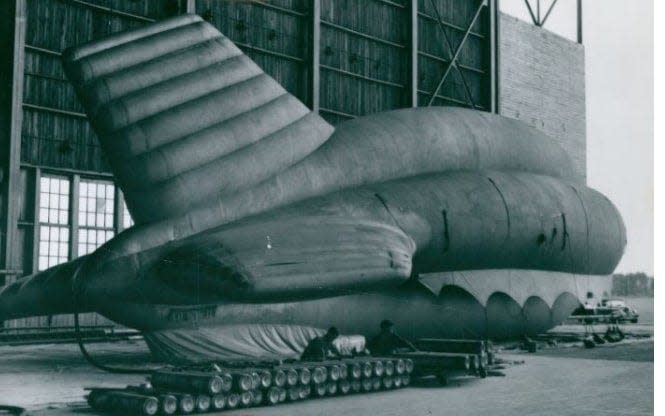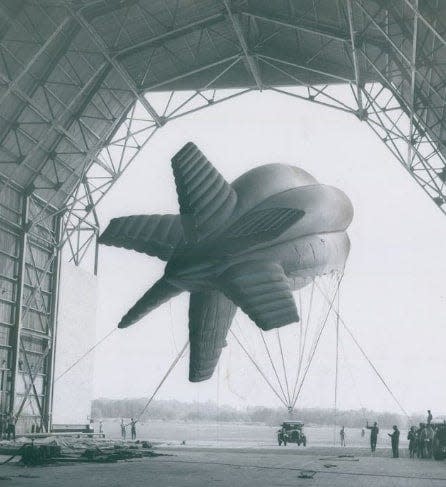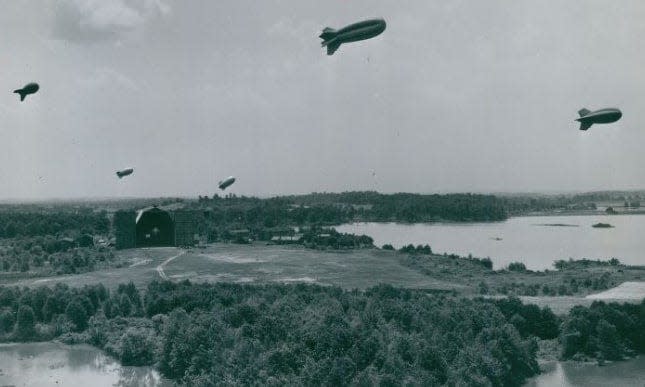Local history: Akron runaway balloon caused panic in sky

When strange objects float overhead, they’re not necessarily foreign craft. Sometimes they’re of domestic origin.
A torpedo-shaped balloon caused panic in the sky March 12, 1940, after it broke loose from its moorings at Wingfoot Lake in Suffield Township.
Goodyear Aircraft Co. of Akron had been conducting secret tests on a barrage balloon designed to defend an area against aerial attack. Great Britain had already launched lighter-than-air craft to deter German raids during World War II, but this was the only one in the United States. The country wouldn’t enter the conflict for another 21 months.
Tethered to the ground by cables, such high-flying balloons presented dangerous obstacles for enemy planes to dodge.
Goodyear’s finned balloon was 75 feet long and 26 feet in diameter with a capacity of 20,000 cubic feet of helium. It was a gray, cold day at Wingfoot Lake as the ground crew used a winch to lower the bag from an altitude test.
Unexpectedly, the anchor line snapped, straining three other support lines until they also broke loose.
“They just pulled away,” Karl Fickes, Goodyear’s chief of blimp operations, told the Beacon Journal.
The yellowish-brown balloon climbed higher and higher until it disappeared from sight. It wasn’t a secret much longer.

Shoot down a balloon?
Fickes called the incident an accident, and said company officials had “absolutely no suspicion of sabotage.”
B.E. “Shorty” Fulton, manager of Akron Municipal Airport, telephoned Cleveland Municipal Airport to suggest that the National Guard shoot down the balloon because it was a danger to airplanes.
“I don’t know what we can do,” replied William Jarrell, Civil Aeronautics Authority inspector in Cleveland. “It’s like looking for a needle in a haystack. We’d have to locate it first.”
These were the days before radar systems in control towers.
Support local journalism:6 reasons why you should subscribe to the Akron Beacon Journal
Authorities made urgent calls to commercial airlines, ordering pilots to keep their eyes peeled and to fly above 10,000 feet to avoid the runaway balloon. If any plane ran into the flying object, it could be catastrophic.
The valves were designed to release helium when the bag got too high. It would settle at 5,000 feet and then continue to descend after the temperature dropped at dusk.
“We’ve warned all the airlines, so I believe it will not be a hazard,” Jarrell said. “It should come down eventually of its own accord. We wouldn’t shoot it down because that would create a danger for anyone underneath.”
Where would it land? Scientists waited for an answer.
Four hours later, farmer Frank Fiscus happened to look up. He wasn’t sure what he was seeing, but a yellowish-brown object was drifting over his property in Manor Township near Kittanning, Pennsylvania.
He quickly enlisted his neighbors, the four Papciak brothers — Stanley, Adolph, Ted and Edward — to help him capture the intruder.
“We first saw it floating above the woods,” Ted Papciak later told a reporter. “When we grabbed the dangling ropes, a gust of wind shot us up 10 feet at first and we had to turn loose.”
Ropes looped around tree
For nearly an hour, the men attempted to catch the deflating balloon. It must have looked comical as they gave chase, running back and forth, leaping to capture the lines.
“Finally by looping the ropes about a tree we managed to anchor it,” Papciak said.
Goodyear’s balloon had traveled more than 200 miles to the farming community about 50 miles northeast of Pittsburgh. Hundreds of curious townsfolk flocked to the Fiscus farm and crowded around the saggy bag until state police cordoned off the area.
More than half of the helium had escaped, but the balloon was mostly undamaged except for a small puncture on the side and a scuffed tail that had been trampled by onlookers. The delicate instruments on board had survived the perilous journey.
Local history:Akron inventor a forgotten genius
Goodyear officials were relieved that no one was hurt. A crew arrived the next day to empty the balloon, fold it up and load it in a truck bound for Akron, where it would be patched and relaunched.
Engineers studied the Wingfoot Lake accident carefully, aiming to prevent another runaway.
“We may put on a new type of rigging or just stronger ropes,” Goodyear balloon expert J.F. Cooper said.
The barrage balloon rose again that summer for more testing. A year later, the Ohio sky was teeming with them.

Airlines and control towers received a teletype warning in February 1941.
“Goodyear Tire & Rubber Co. test flights are about to be conducted with six high and low altitude balloons,” it read. “These balloons are inflated with helium and are being flown simultaneously at various altitudes. The flights will be conducted at the Wingfoot Lake station near Suffield.”
You can bet those cables were extra secure.
Mark J. Price can be reached at mprice@thebeaconjournal.com.
Geauga Lake revisited:Vintage photos of lost amusement park
This article originally appeared on Akron Beacon Journal: Local history: Akron runaway balloon caused panic in sky

